Numerical Study of Bearing Capacity of the Pile-Supported Embankments for the Flexible Floating, Rigid Floating and End-Bearing Piles
Abstract
:1. Introduction
2. Three Typical Field Cases Studies
2.1. The Flexible Floating Pile
2.1.1. Site Conditions
2.1.2. Finite Element Model
2.1.3. Model Validation
2.2. The Rigid Floating Pile
2.2.1. Site Conditions
2.2.2. Finite Element Model
2.2.3. Model Validation
2.3. The End-Bearing Pile
2.3.1. Site Conditions
2.3.2. Finite Element Model
2.3.3. Model Validation
3. Results and Discussion
3.1. Pile-Soil Interaction
3.1.1. Skin Friction of the Pile
3.1.2. Axial Force Distributions along with the Pile
3.2. Development of Soil Arching
3.2.1. Stress Reduction Ratio
3.2.2. Earth Pressure Coefficient
3.2.3. Differential Settlement
4. Conclusions
- The pile tip resistance of flexible floating piles was the lowest, only 10% of that of end-bearing piles. It means that the flexible floating piles mainly rely on the pile skin friction to carry the load. End-bearing piles mainly rely on pile tip resistance to carry the load, which has 50% as much skin friction as flexible floating piles. In comparison, the load-carrying mechanism of the rigid floating piles was somehow in between.
- The SRR decreased from 0.90 for flexible floating piles to 0.61 for rigid floating piles and reached 0.44 for end-bearing piles. The K in the embankment employing end-bearing pile was 3.28 at , greater than KP, in which the soil arching was fully developed. The K for rigid floating pile-supported embankment was 2.21 at , where soil arching might be partially mobilized. At the bottom of the flexible floating pile-supported embankment, the K tended to equal K0, and thus soil arching was insignificant.
- The differential settlement on the surface of the end-bearing pile-supported embankment was 0 mm because the arching was fully developed. The development of soil arching was initiated once the embankment construction period, and it further developed with the evolution of soil consolidation until a full arching was mobilized. So, it was essential to consider the soil consolidation in the study of the pile-supported embankment.
- The mechanical behavior and bearing mechanism of pile-supported embankments are significantly different under different pile types. There are two types of floating piles in the practical engineering, and it is unsafe and uneconomical to design follow a uniform guideline. It was economical to choose the flexible floating pile when the thickness of the soft clay was quite high. However, there may be insufficient bearing capacity. Using the end-bearing pile might significantly improve the bearing capacity of the embankment, but it was not cost-effective because of its limited lift compared to the rigid floating pile.
Author Contributions
Funding
Institutional Review Board Statement
Informed Consent Statement
Data Availability Statement
Conflicts of Interest
References
- Bouassida, M.; Fattah, M.Y.; Mezni, N. Bearing Capacity of Foundation on Soil Reinforced by Deep Mixing Columns. Geomech. Geoengin. 2022, 17, 309–320. [Google Scholar] [CrossRef]
- King, L.; Bouazza, A.; Dubsky, S.; Rowe, R.K.; Gniel, J.; Bui, H.H. Kinematics of soil arching in piled embankments. Géotechnique 2019, 69, 941–958. [Google Scholar] [CrossRef]
- Rui, R.; Han, J.; Zhang, L.; Zhai, Y.; Cheng, Z.; Chen, C. Simplified method for estimating vertical stress-settlement responses of piled embankments on soft soils. Comput. Geotech. 2020, 119, 103365. [Google Scholar] [CrossRef]
- Phutthananon, C.; Jongpradist, P.; Dias, D.; Jamsawang, P. Numerical study of the deformation performance and failure mechanisms of TDM pile-supported embankments. Transp. Geotech. 2021, 30, 100623. [Google Scholar] [CrossRef]
- Pham, T.A.; Dias, D. A simplified model for the analysis of piled embankments considering arching and subsoil consolidation. Geotext. Geomembr. 2022, 50, 408–431. [Google Scholar] [CrossRef]
- Wang, K.; Cao, J.; Wang, X.; Ning, Y. Soil Arching of Piled Embankment in Equal Settlement Pattern: A Discrete Element Analysis. Symmetry 2021, 13, 1627. [Google Scholar] [CrossRef]
- Cao, W.Z.; Zheng, J.J.; Zhang, J.; Zhang, R.J. Field test of a geogrid-reinforced and floating pile-supported embankment. Geosynth. Int. 2016, 23, 348–361. [Google Scholar] [CrossRef]
- Jamsawang, P.; Yoobanpot, N.; Thanasisathit, N.; Voottipruex, P.; Jongpradist, P. Three-dimensional numerical analysis of a DCM column-supported highway embankment. Comput. Geotech. 2016, 72, 42–56. [Google Scholar] [CrossRef]
- Ng, K.S.; Tan, S.A. Nonlinear Behaviour of an Embankment on Floating Stone Columns. Geomech. Geoengin. 2014, 10, 30–44. [Google Scholar] [CrossRef]
- Liu, K.W.; Rowe, R.K. Numerical modelling of prefabricated vertical drains and surcharge on reinforced floating column-supported embankment behaviour. Geotext. Geomembr. 2015, 43, 493–505. [Google Scholar] [CrossRef]
- Liu, H.L.; Ng, C.W.W.; Fei, K. Performance of a Geogrid-Reinforced and Pile-Supported Highway Embankment over Soft Clay: Case Study. J. Geotech. Geoenviron. Eng. 2007, 133, 1483–1493. [Google Scholar] [CrossRef]
- Rowe, R.K.; Liu, K.W. Three-dimensional finite element modelling of a full-scale geosynthetic-reinforced, pile-supported embankment. Can. Geotech. J. 2015, 52, 2041–2054. [Google Scholar] [CrossRef]
- Han, J.; Gabr, M.A. Numerical analysis of geosynthetic-reinforced and pile-supported earth platforms over soft soil. J. Geotech. Geoenviron. Eng. 2002, 128, 44–53. [Google Scholar] [CrossRef]
- Projet National ASIRI. Recommendations for the Design, Construction and Control of Rigid: Inclusion Ground Improvements; Presses des Ponts: Paris, France, 2013. [Google Scholar]
- GGS. Recommendations for Design and Analysis of Earth Structures Using Geosynthetic Reinforcements—EBGEO; German Geotechnical Society: Berlin, Germany, 2011. [Google Scholar]
- Satibi, S. Numerical Analysis and Design Criteria of Embankments on Floating Piles; Institut für Geotechnik der Universität Stuttgart IGS: Stuttgart, Germany, 2009. [Google Scholar]
- van Eekelen, S.J.M.; Bezuijen, A.; van Tol, A.F. Analysis and modification of the British Standard BS8006 for the design of piled embankments. Geotext. Geomembr. 2011, 29, 345–359. [Google Scholar] [CrossRef]
- Xu, C.; Song, S.; Han, J. Scaled model tests on influence factors of full geosynthetic-reinforced pile-supported embankments. Geosynth. Int. 2016, 23, 140–153. [Google Scholar] [CrossRef]
- Bhasi, A.; Rajagopal, K. Numerical study of basal reinforced embankments supported on floating/end bearing piles considering pile-soil interaction. Geotext. Geomembr. 2015, 43, 524–536. [Google Scholar] [CrossRef]
- Pham, T.A. Design and analysis of geosynthetic-reinforced and floating column-supported embankments. Int. J. Geotech. Eng. 2021, 1–17. [Google Scholar] [CrossRef]
- Hong, W.P.; Lee, J.; Hong, S. Full-Scale Tests on Embankments Founded on Piled Beams. J. Geotech. Geoenvironmental Eng. 2014, 140, 04014067. [Google Scholar] [CrossRef]
- Yadav, S.K.; Ye, G.-L.; Khalid, U.; Fukuda, M. Numerical and centrifugal physical modelling on soft clay improved with floating and fixed sand compaction piles. Comput. Geotech. 2019, 115, 103160. [Google Scholar] [CrossRef]
- Wang, A.; Zhang, D. Lateral Response and Failure Mechanisms of Rigid Piles in Soft Soils Under Geosynthetic-Reinforced Embankment. Int. J. Civ. Eng. 2019, 18, 169–184. [Google Scholar] [CrossRef]
- Shen, P.; Xu, C.; Han, J. Geosynthetic-reinforced pile-supported embankment: Settlement in different pile conditions. Geosynth. Int. 2020, 27, 315–331. [Google Scholar] [CrossRef]
- Zhou, W.-H.; Chen, R.-P.; Zhao, L.-S.; Xu, Z.-Z.; Chen, Y.-M. A semi-analytical method for the analysis of pile-supported embankments. J. Zhejiang Univ. Sci. A 2012, 13, 888–894. [Google Scholar] [CrossRef]
- Reshma, B.; Rajagopal, K.; Viswanadham, B.V.S. Centrifuge model studies on the settlement response of geosynthetic piled embankments. Geosynth. Int. 2020, 27, 170–181. [Google Scholar] [CrossRef]
- Zhang, H.; Wang, H.; Li, X.; Li, W.; Wu, J.; Lv, C.; Song, X.; Liu, M. An Analysis of Floating Geogrid-Reinforced Pile-Supported Embankments Containing Deep Softened Soil. Arab. J. Sci. Eng. 2021, 46, 10855–10868. [Google Scholar] [CrossRef]
- Terzaghi, K.T. Theoretical Soil Mechanics; John Wiley and Sons, Inc.: Hoboken, NJ, USA, 1943. [Google Scholar]
- Hewlett, W.J.; Randolph, M.F. Analysis of piled embankments. Ground Eng. 1988, 21, 12–18. [Google Scholar]
- Zhuang, Y.; Cui, X. Analysis and modification of the Hewlett and Randolph method. Proc. Inst. Civ. Eng.-Geotech. Eng. 2015, 168, 144–157. [Google Scholar] [CrossRef]
- Zhuang, Y.; Wang, K.Y. Finite-element analysis of arching in highway piled embankments subjected to moving vehicle loads. Géotechnique 2018, 68, 857–868. [Google Scholar] [CrossRef]
- BSI. BS 8006-1; Code of Practice for Strengthened/Reinforced Soils and Other Fills, Incorporating Corrigendum 1. British Standards Institution: London, UK, 2012.
- Pham, T.A.; Wijesuriya, K.; Dias, D. Analytical model for the design of piled embankments considering cohesive soils. Geosynth. Int. 2022, 29, 369–388. [Google Scholar] [CrossRef]
- Pham, T.A.; Dias, D. 3D numerical study of the performance of geosynthetic-reinforced and pile-supported embankments. Soils Found. 2021, 61, 1319–1342. [Google Scholar] [CrossRef]
- SIMULIA. ABAQUS/CAE User’s Manual; Dassault: Pawtucket, RI, USA, 2020. [Google Scholar]
- Smith, M.; Filz, G. Axisymmetric numerical modeling of a unit cell in geosynthetic-reinforced, column-supported embankments. Geosynth. Int. 2007, 14, 13–22. [Google Scholar] [CrossRef]
- Ariyarathne, P.; Liyanapathirana, D.S.; Leo, C.J. Comparison of Different Two-Dimensional Idealizations for a Geosynthetic-Reinforced Pile-Supported Embankment. Int. J. Geomech. 2013, 13, 754–768. [Google Scholar] [CrossRef]
- Briançon, L.; Simon, B. Performance of Pile-Supported Embankment over Soft Soil: Full-Scale Experiment. J. Geotech. Geoenvironmental Eng. 2012, 138, 551–561. [Google Scholar] [CrossRef]
- Zhuang, Y.; Ellis, E.A.; Yu, H.S. Plane strain FE analysis of arching in a piled embankment. Proc. Inst. Civ. Eng.-Ground Improv. 2010, 163, 207–215. [Google Scholar] [CrossRef]
- Zhuang, Y.; Ellis, E.; Yu, H.S. Three-dimensional finite-element analysis of arching in a piled embankment. Géotechnique 2012, 62, 1127–1131. [Google Scholar] [CrossRef]


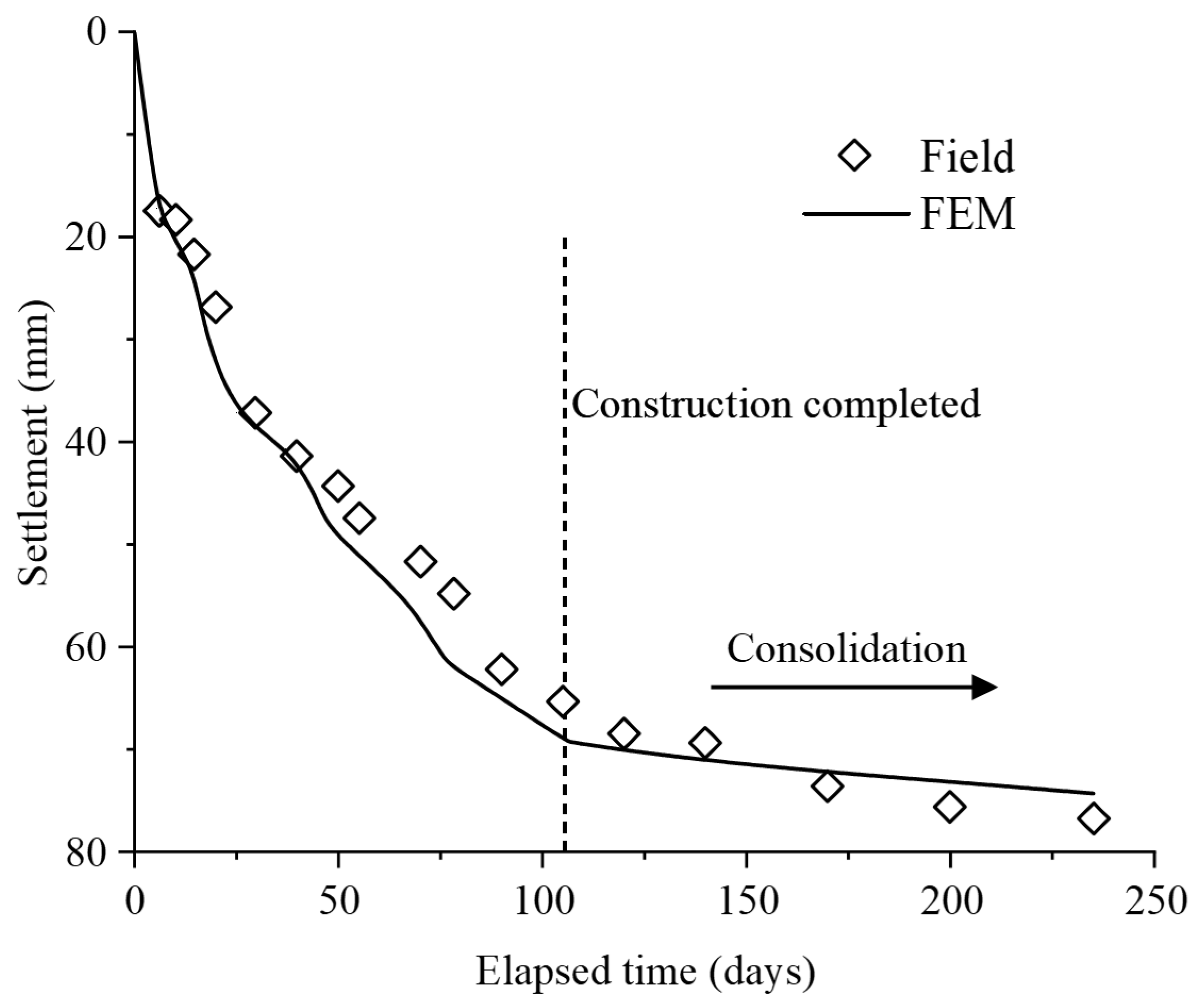
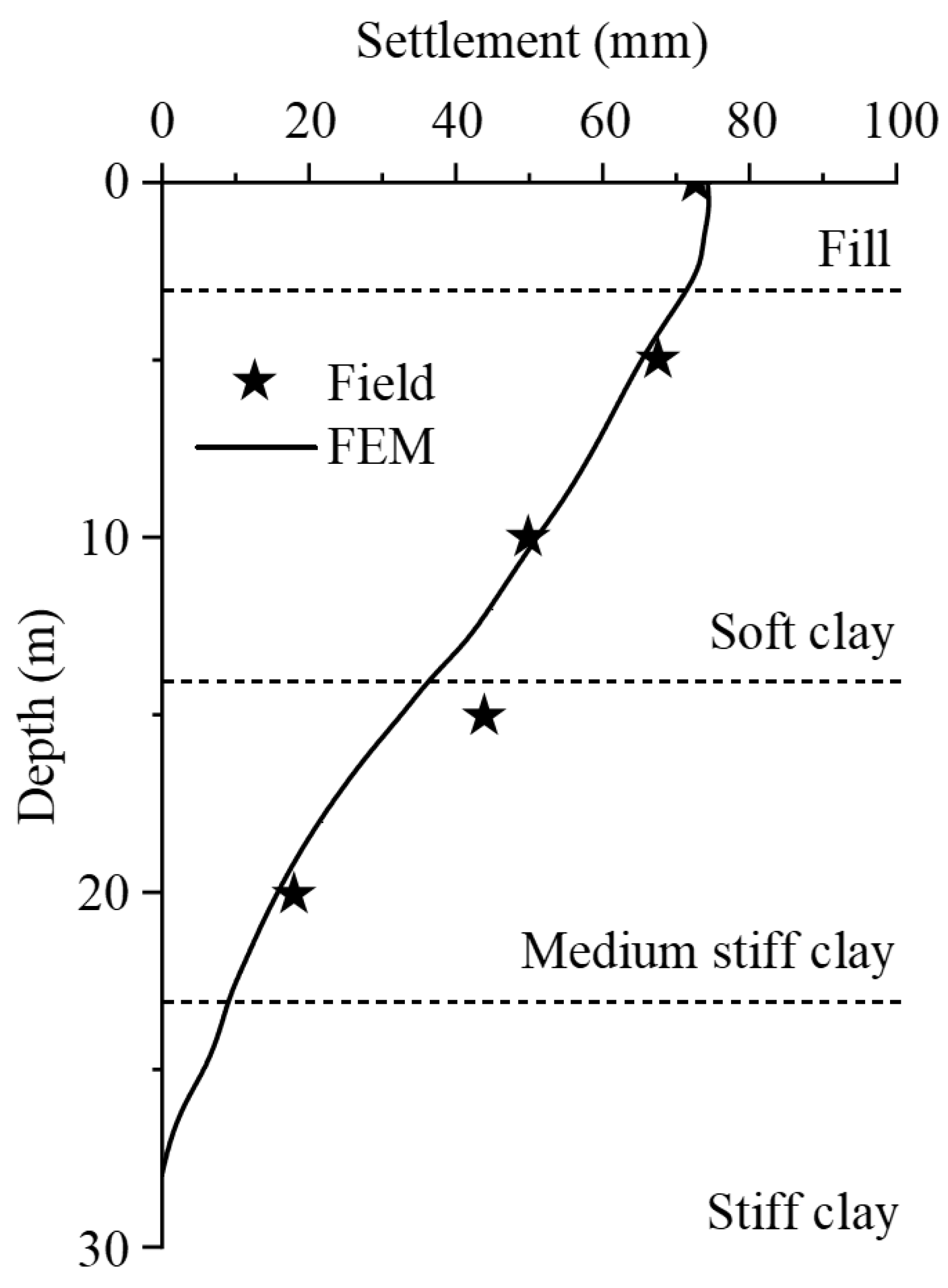


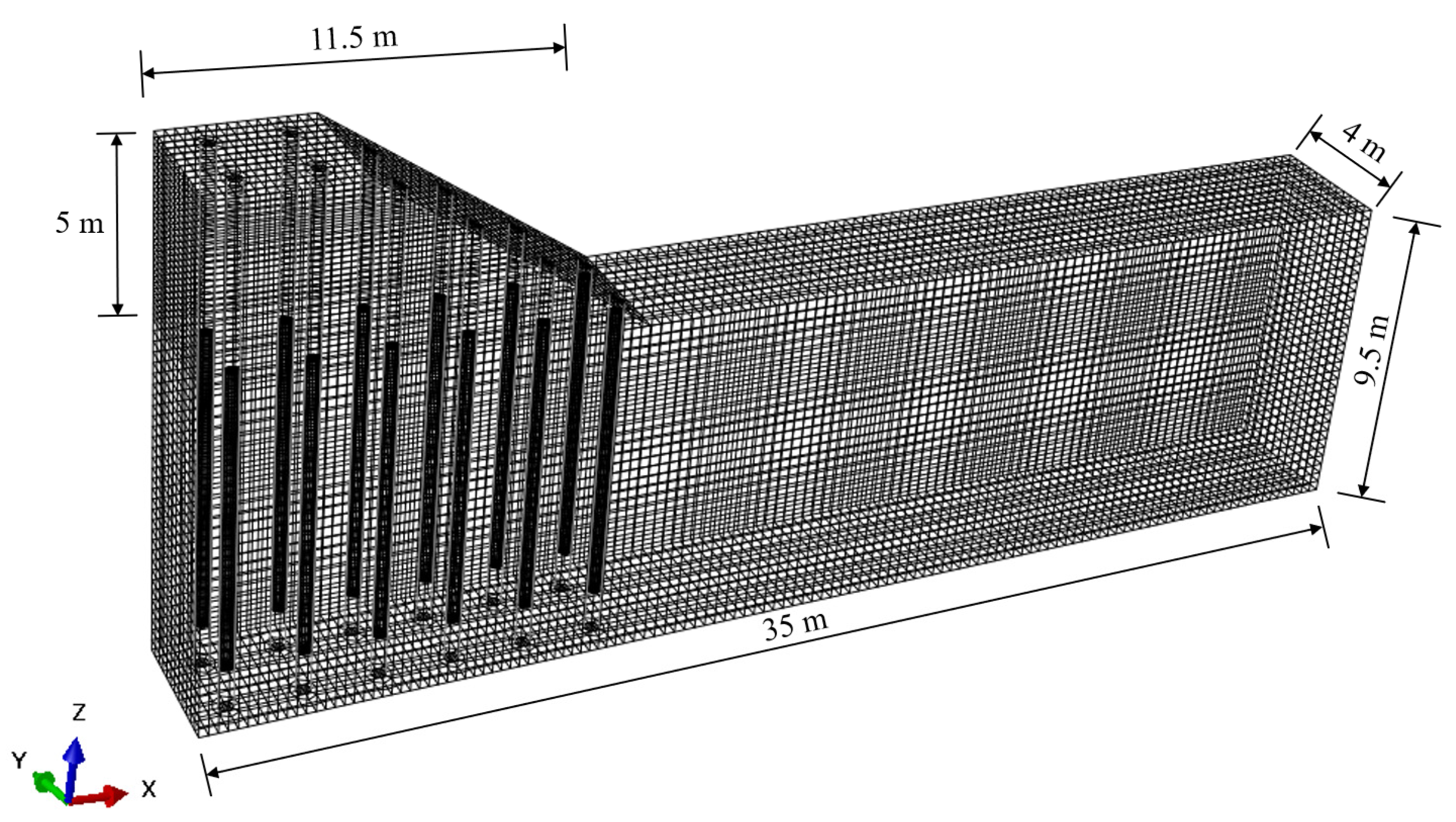

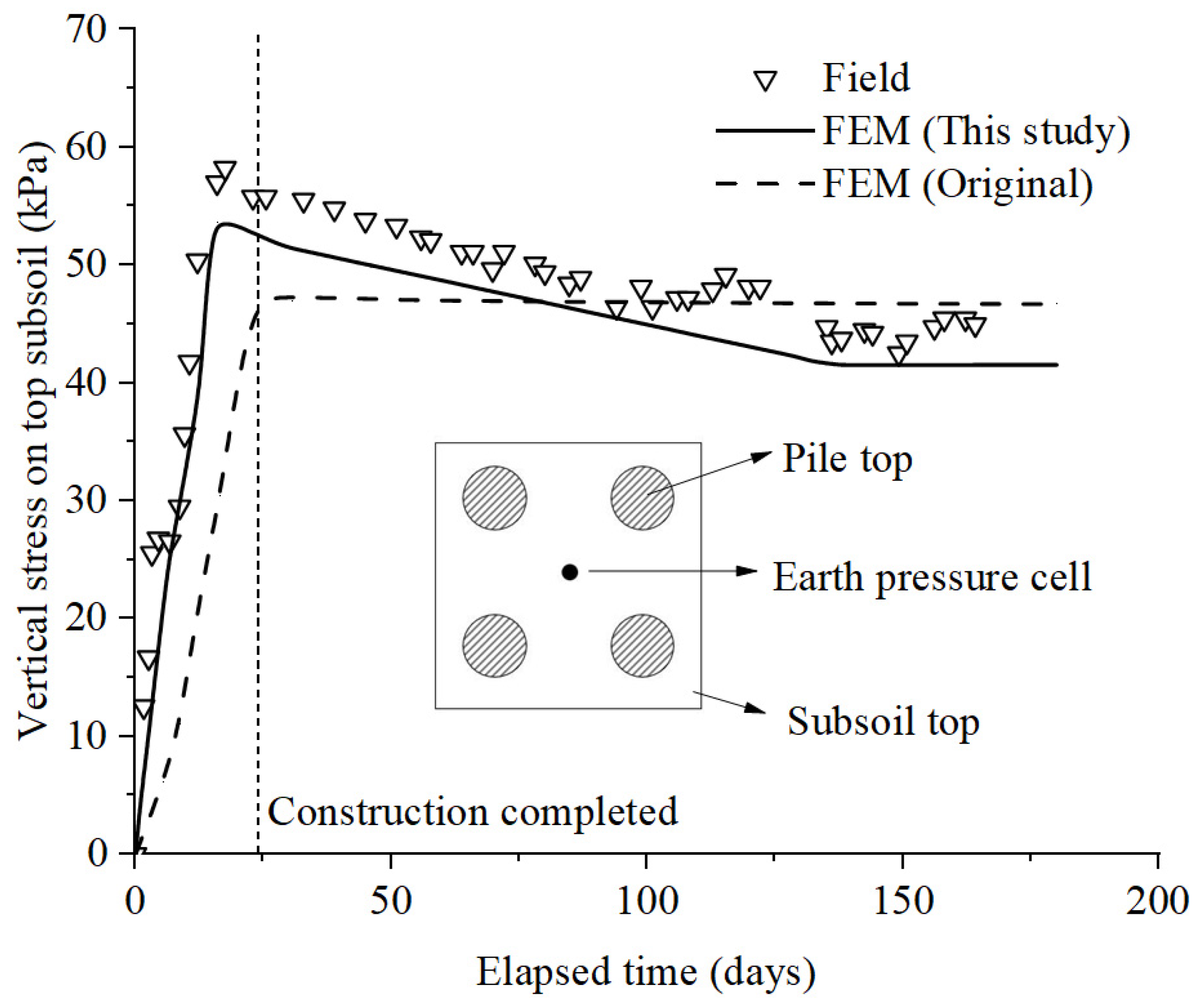
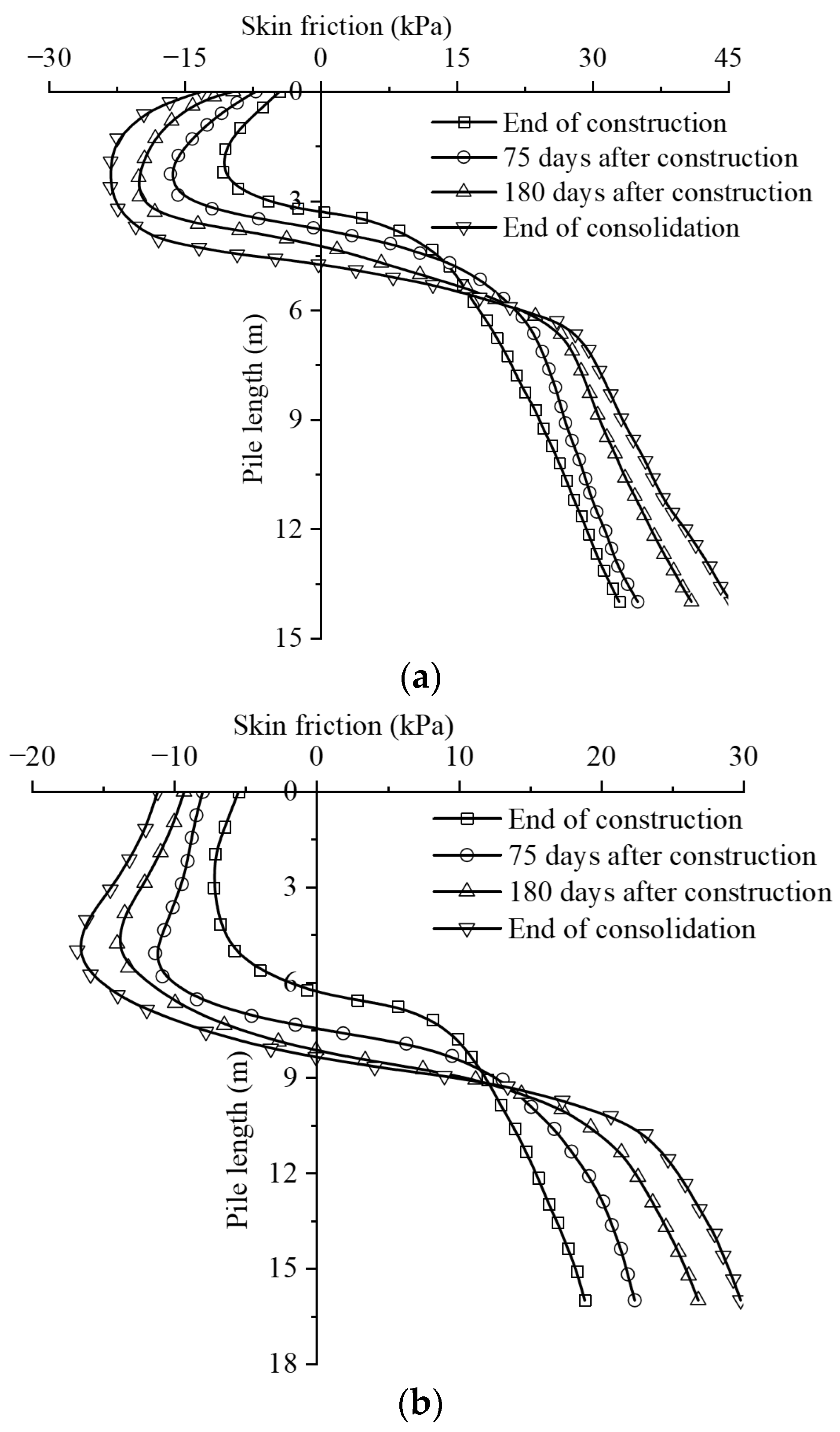
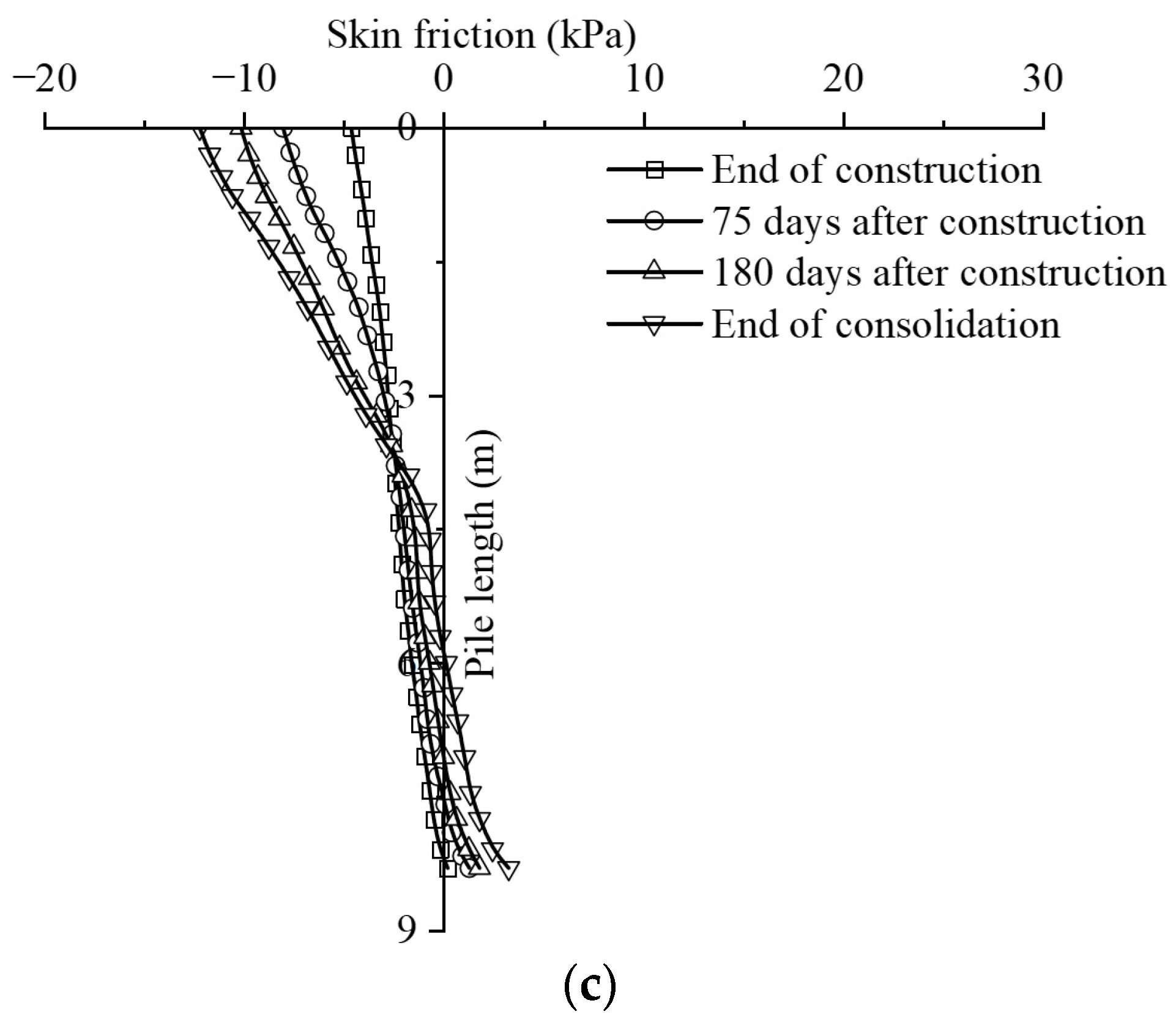
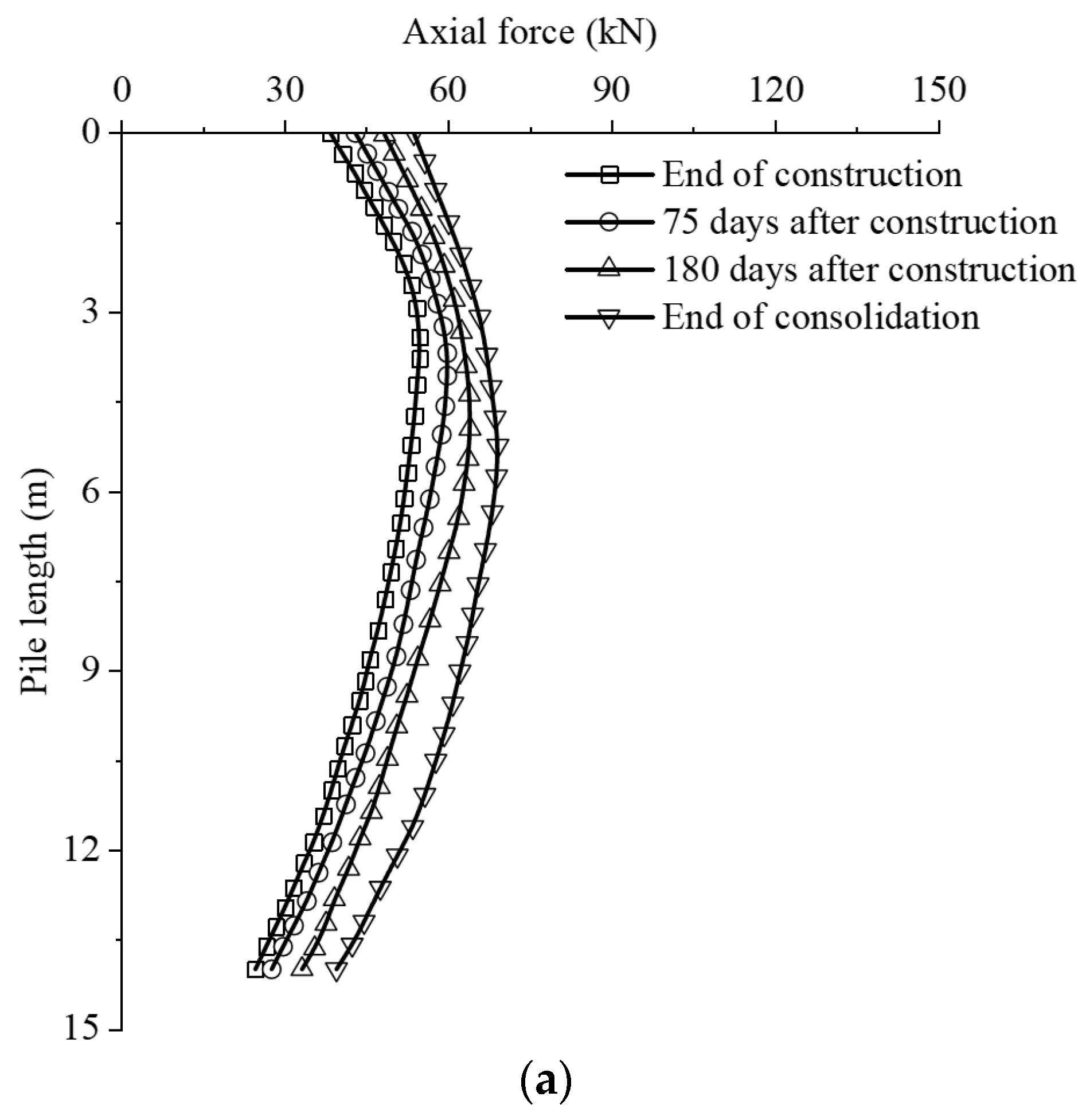
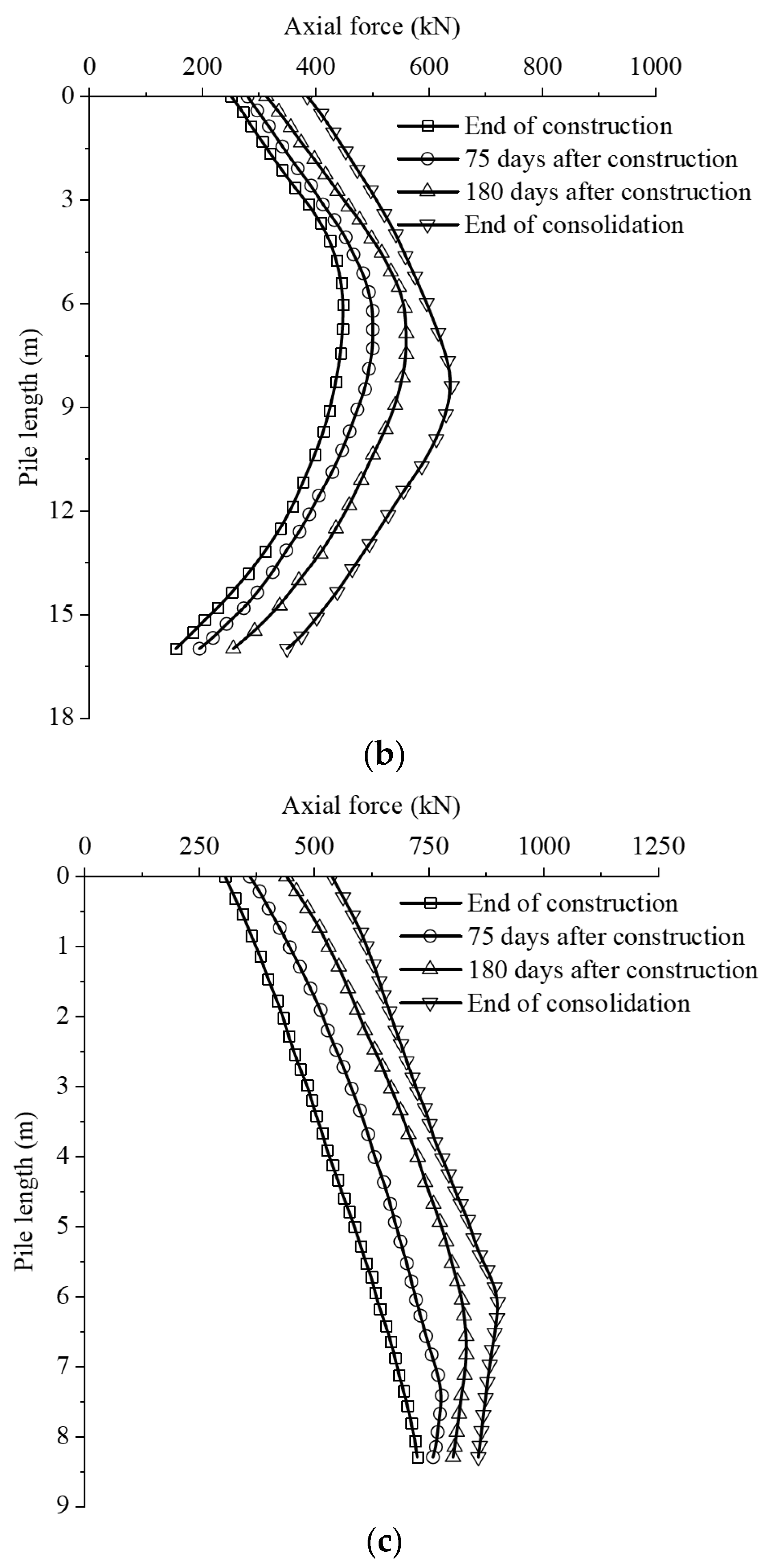
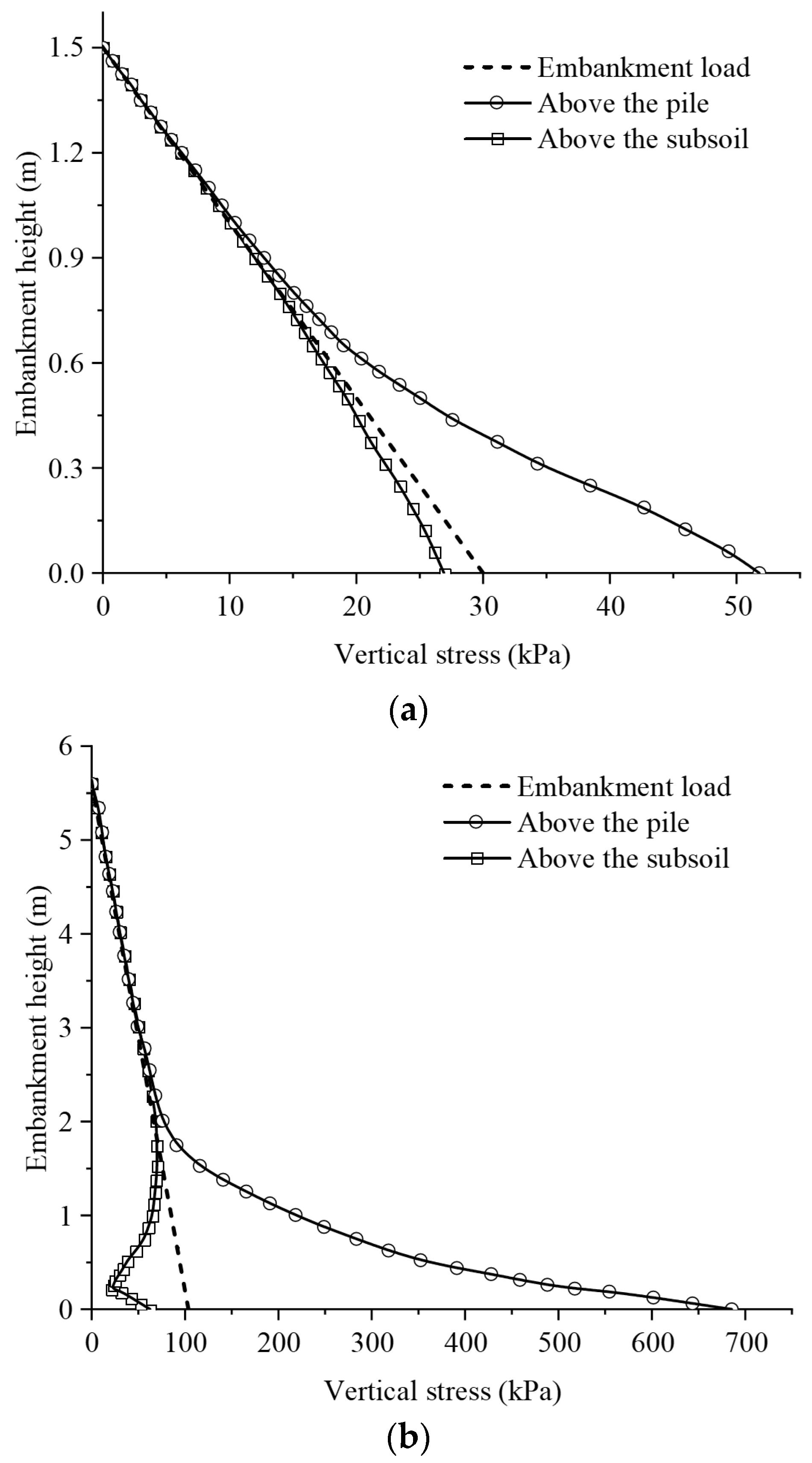
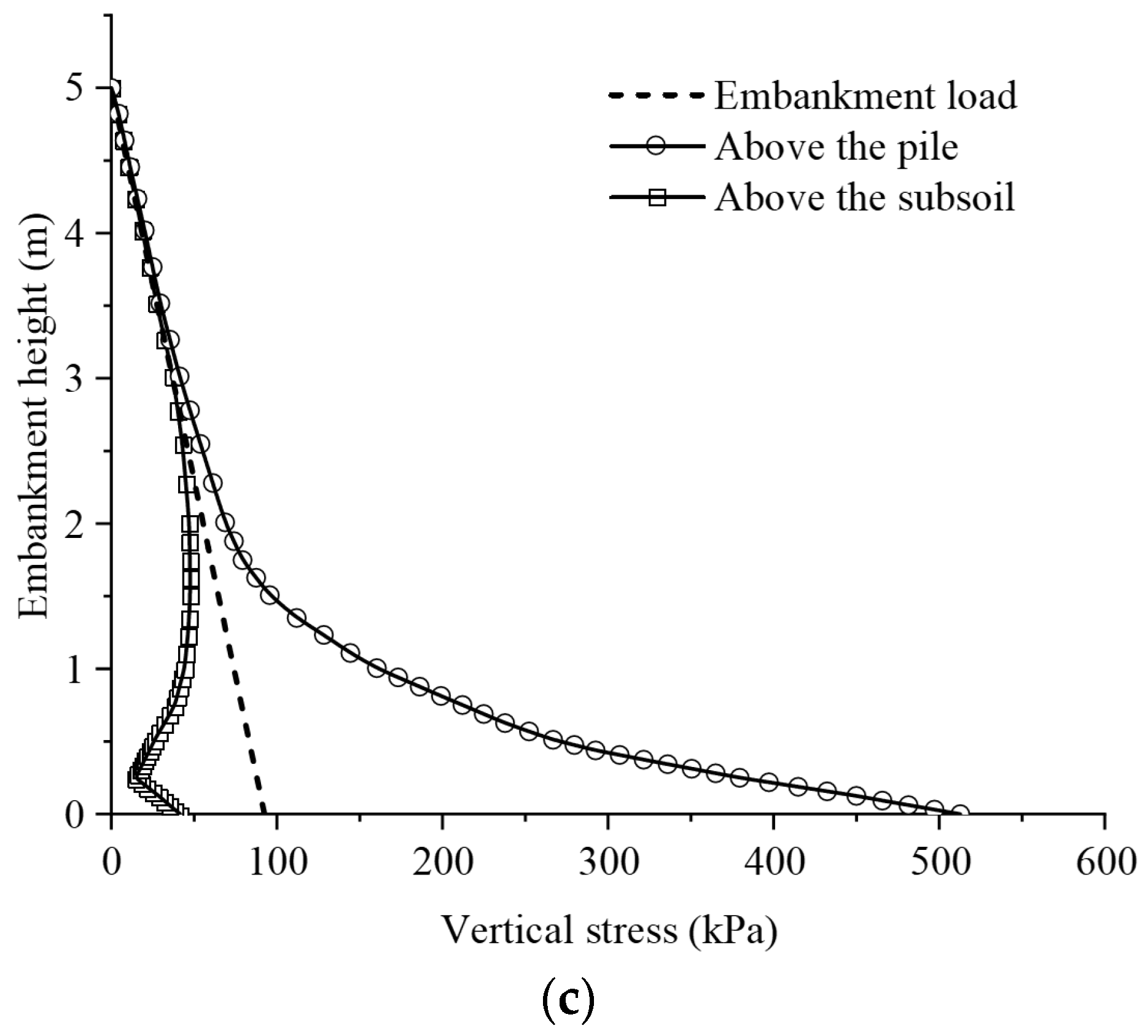

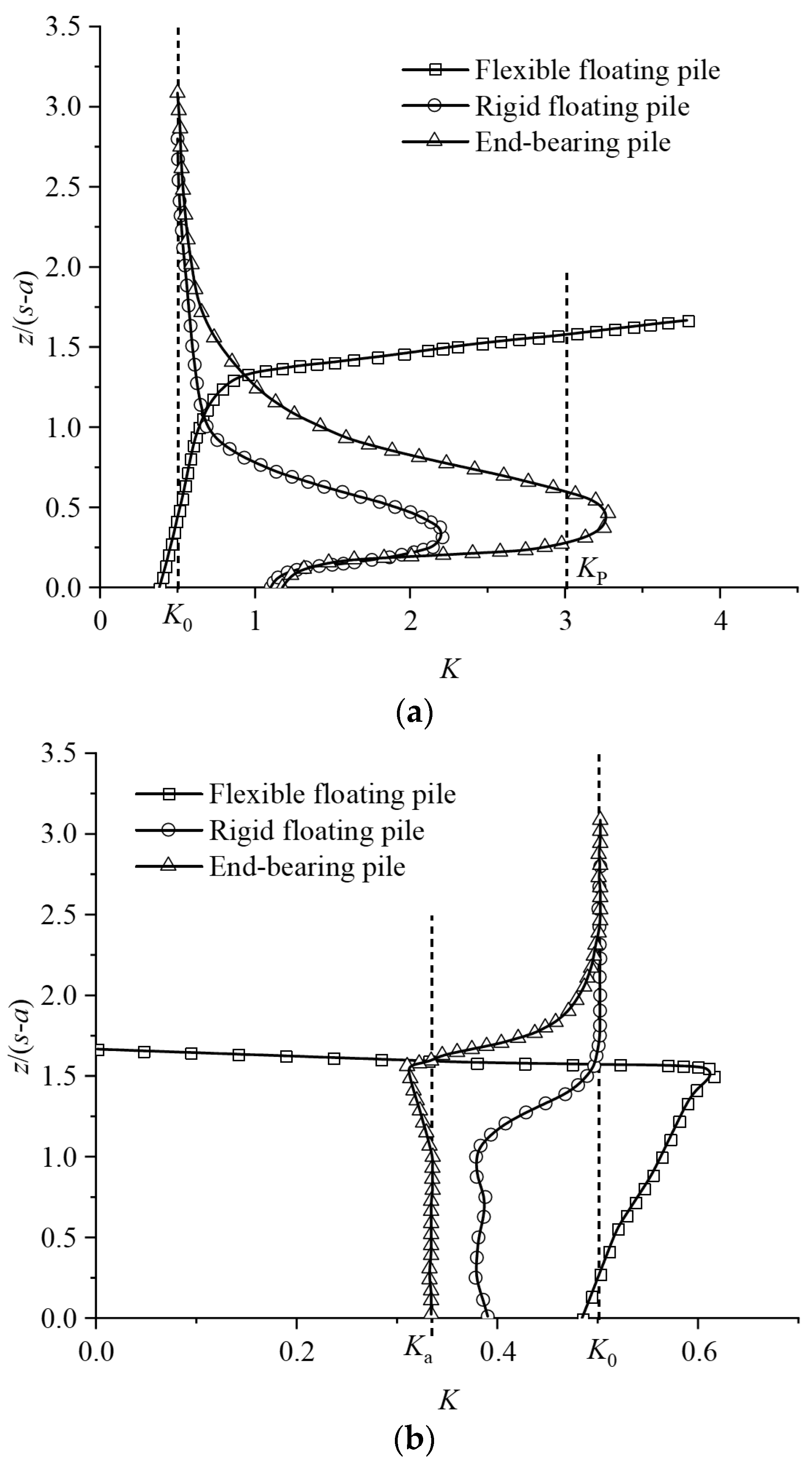
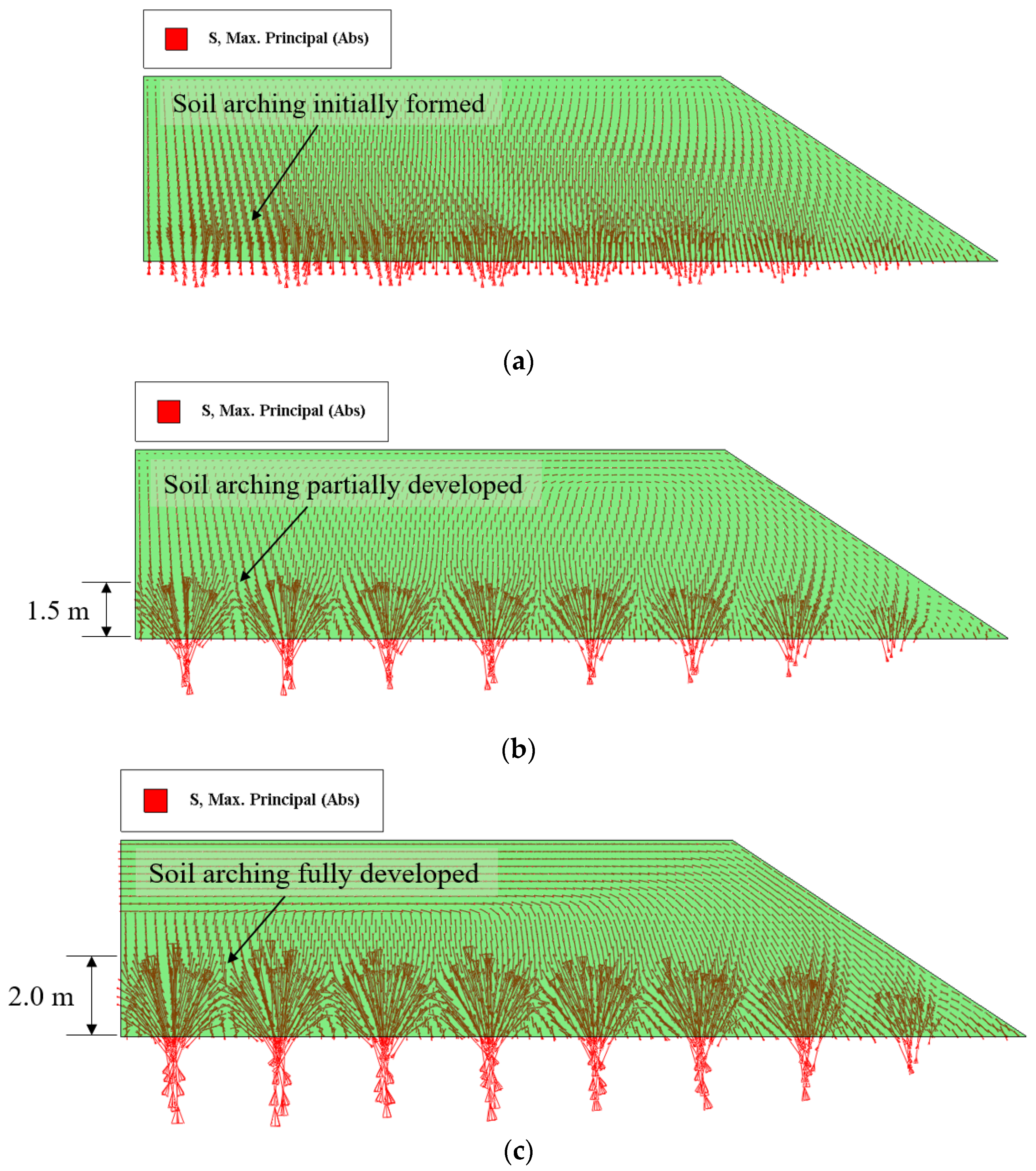
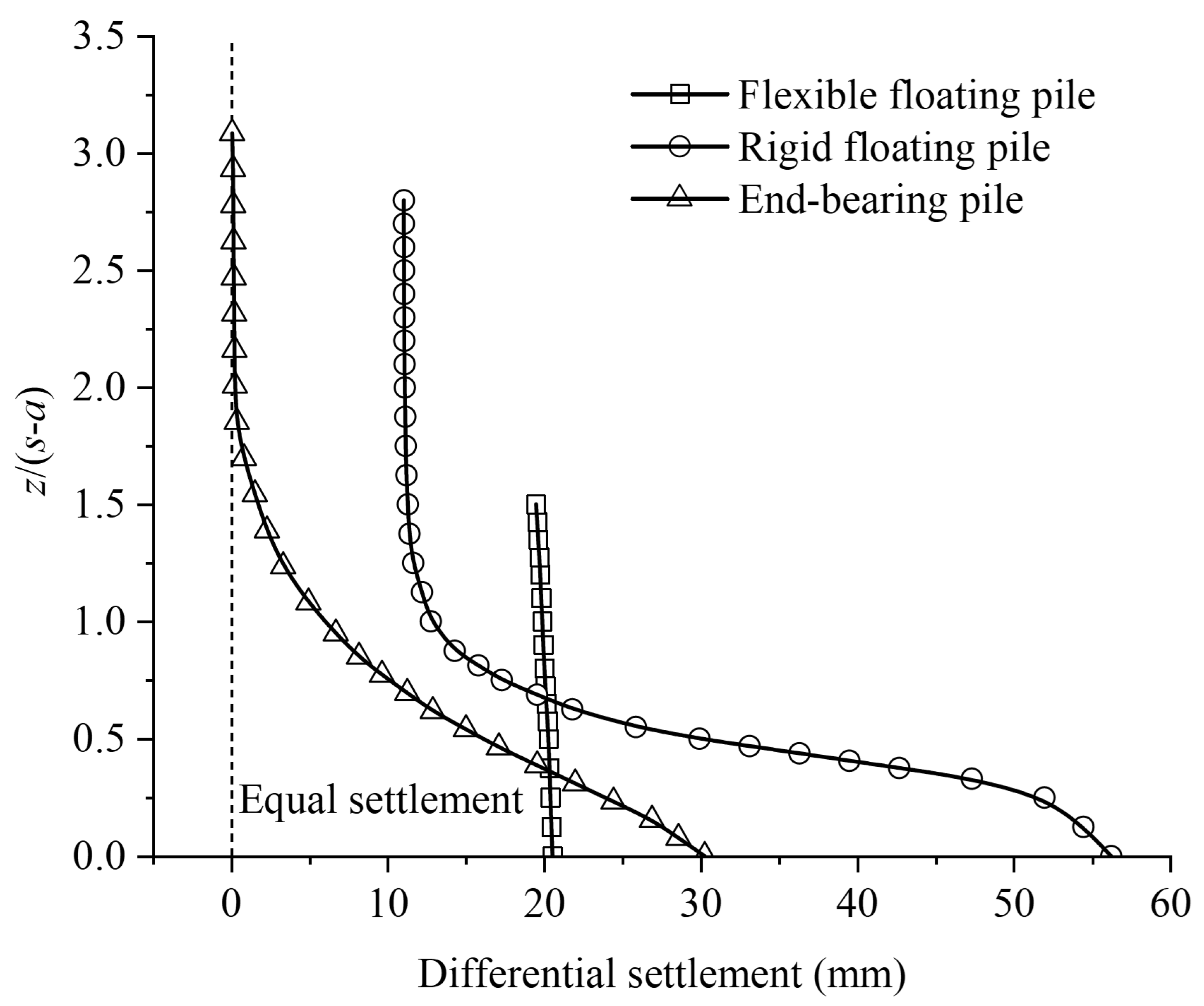
| Soil Layer | γ (kN/m3) | E (MPa) | v | λ | κ | c′ (kPa) | φ′ (°) | k (m/d) |
|---|---|---|---|---|---|---|---|---|
| Embankment | 20 | 20 | 0.33 | - | - | 1 | 30 | - |
| Fill | 20 | 30 | 0.33 | - | - | 1 | 32 | - |
| Soft clay | 14 | - | 0.35 | 0.18 | 0.04 | 1 | 23 | 5 × 10−4 |
| Medium stiff clay | 16 | - | 0.15 | 0.12 | 0.06 | 10 | 25 | 2.5 × 10−4 |
| Material | γ (kN/m3) | E (MPa) | φ′ (°) | v | λ | κ | e1 | K × 10−4 (m/d) |
|---|---|---|---|---|---|---|---|---|
| Pile | 24.0 | 20,000 | - | 0.20 | - | - | - | - |
| Embankment | 18.5 | 20 | 30 | 0.30 | - | - | - | - |
| Gravel | 18.5 | 20 | 40 | 0.30 | - | - | - | |
| Fill | 18.5 | 7 | 28 | 0.30 | - | - | - | - |
| Silty clay | 20.0 | - | - | 0.35 | 0.06 | 0.012 | 0.87 | 8.64 |
| Soft silty clay | 17.0 | - | - | 0.40 | 0.15 | 0.030 | 1.79 | 4.32 |
| Medium silty clay | 20.5 | - | - | 0.35 | 0.05 | 0.010 | 1.10 | 4.32 |
| Sandy silt | 20.0 | - | - | 0.35 | 0.03 | 0.005 | 0.28 | 43.2 |
| Soil Layer | Material | γ (kN/m3) | φ′ (°) | e0 | v | λ | κ | k (m/s) |
|---|---|---|---|---|---|---|---|---|
| S1 | Clayey backfill | 20.0 | 30.6 | 0.75 | 0.35 | 0.092 | 0.014 | - |
| S2 | Clayey backfill | 20.0 | 30.6 | 1.30 | 0.36 | 0.191 | 0.029 | - |
| S3 | Beige clay | 14.0 | 30.6 | 2.00 | 0.37 | 0.308 | 0.046 | 8.8 × 10−8 |
| S4 | Clayey gray sand | 19.0 | 30.6 | 0.70 | 0.35 | 0.074 | 0.011 | 1.0 × 10−6 |
| S5 | Lightly plastic clay | 20.5 | 27.0 | 0.90 | 0.32 | 0.116 | 0.017 | 6.1 × 10−7 |
| S6 | Sandy clay | 20.5 | 27.0 | 0.80 | 0.32 | 0.088 | 0.013 | 6.1 × 10−7 |
| S7 | Gravel | 21.0 | 34.0 | 0.75 | 0.31 | 0.027 | 0.004 | 6.6 × 10−5 |
| Material | γ (kN/m3) | E (MPa) | v | c′ (kPa) | φ′ (°) |
|---|---|---|---|---|---|
| Embankment | 18.5 | 20 | 0.3 | 10 | 30 |
| Gravel (cushion) | 20 | 70 | 0.3 | 60 | 36 |
| Pile | 24 | 20,000 | 0.2 | 18,000 | - |
Publisher’s Note: MDPI stays neutral with regard to jurisdictional claims in published maps and institutional affiliations. |
© 2022 by the authors. Licensee MDPI, Basel, Switzerland. This article is an open access article distributed under the terms and conditions of the Creative Commons Attribution (CC BY) license (https://creativecommons.org/licenses/by/4.0/).
Share and Cite
Hu, S.; Zhuang, Y.; Wu, Y.; Zhang, X.; Dong, X. Numerical Study of Bearing Capacity of the Pile-Supported Embankments for the Flexible Floating, Rigid Floating and End-Bearing Piles. Symmetry 2022, 14, 1981. https://doi.org/10.3390/sym14101981
Hu S, Zhuang Y, Wu Y, Zhang X, Dong X. Numerical Study of Bearing Capacity of the Pile-Supported Embankments for the Flexible Floating, Rigid Floating and End-Bearing Piles. Symmetry. 2022; 14(10):1981. https://doi.org/10.3390/sym14101981
Chicago/Turabian StyleHu, Shunlei, Yan Zhuang, Yifan Wu, Xidong Zhang, and Xiaoqiang Dong. 2022. "Numerical Study of Bearing Capacity of the Pile-Supported Embankments for the Flexible Floating, Rigid Floating and End-Bearing Piles" Symmetry 14, no. 10: 1981. https://doi.org/10.3390/sym14101981
APA StyleHu, S., Zhuang, Y., Wu, Y., Zhang, X., & Dong, X. (2022). Numerical Study of Bearing Capacity of the Pile-Supported Embankments for the Flexible Floating, Rigid Floating and End-Bearing Piles. Symmetry, 14(10), 1981. https://doi.org/10.3390/sym14101981






